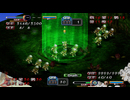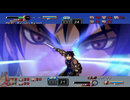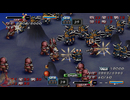|
Even with the increase in popularity felt by gaming in general in the past few years, there are still a great
many games produced in Japan that never see their way to North America. Generation of Chaos is one such series.
The fourth in a series of games noted for unusual and difficult tactical challenges, Generation of Chaos combines
a number of unusual design concepts into an interesting and unique tactical RPG. So what’s it all about?
|
"The game system is perhaps best described as a combination of Civilization’s world building, Warcraft’s RTS combat, and the board game Risk." |
The game's plot takes place in an area of the world called the Lost Grounds, and follows events after the Dravanian
Restoration, a period of turmoil during which the King of Dravania was deposed. A minister by the name of Zeo rose in
his place, christened himself Emperor, and began remaking Dravania in his own militaristic image. At the beginning of
the game, the player selects to play as either Gena of Dravania or Allen of Zodia, a kingdom far to the west of Dravania.
The game opens with a cinema sequence that uses some unusual visual elements. Anime-style character designs appear next
to pseudo-Paleolithic cave art and World War II-era quotations, all tied together using some very modern movie-like effects
and the rock theme song "Hot Water", by a group called Dogschool. It is an unusual group of elements to be sure, but it suits
the game. Generation of Chaos feels very much like an aggregation of strange concepts which one would not normally associate
with each other, and yet it works. The game’s unusual setup, which is part real-time strategy and part world-builder simulation,
is so drastically different from other strategy RPGs that explaining it can be a little difficult.
The game system is perhaps best described as a combination of Civilization’s world building, Warcraft’s RTS combat, and the board
game Risk. To explain; the playing field is set up something like a board game, with set paths that the player can traverse. Towns,
mines and other landmarks are set up along these paths, and can be captured to increase the player’s income. Of course, not all areas
provide income - some, like Graveyards, may force the player into a random encounter, while others simply act as way stations where
units can be replenished. The most important areas are Towns and Forts, which act as military centers for the player. These areas
provide some measure of defense for the characters who inhabit it, and can be further fortified to make them more impressive and harder
to breach. Beyond simple defense, Towns and Forts also have a Market, which like the town’s defenses, can be built up over time to
provide better items. A Market that starts out selling only Green Herbs and swords, for instance, can be improved to the point where
they sell rare Skills and even Super Moves. Although the goal of the game is military in nature, building up a prosperous kingdom is just as
interesting.
Combat itself takes place on a reasonably small field of play, much longer than it is wide. The player and enemy start at opposite
ends of the field of combat, select a formation and operation, and combat begins. The formation is simply the position of each of the
player’s thirty units, which is the maximum number allowed in any battalion - twenty-nine soldiers and one Commander. Soldiers can be
anything from basic Fighters to Archers and Gunners, even monsters like Zombies, Skeletons and Hikkyo Bugs, or different races, like
Birdmen, Mermen and Lizardmen, all depending on the Commander. Unlike formation, which alters the statistics of the units based on
whether the formation is aggressive or defensive, operation is just the general command given to the soldiers. Crush, Wait, Target
Commander, and Defend Commander are the usual four, and are more or less self-explanatory. Once formation and operation have been
selected, battle begins in earnest. During combat, the players can direct the general movement of their units and change operation
on the fly, as well as select Skill and Super Move use, but by and large the battles play out without a great deal of player input.
Visually, the game is a little reminiscent of NIS games, but the tone of Generation of Chaos is far darker than the company’s
previous titles have been, and the visual style reflects this. Of course, this still being NIS,
there are still a few moments of humor in the game, particularly in item descriptions. But perhaps the most impressive part of the
game, visually speaking, comes in the form of Super Moves. Really more Summons than anything else, using a Super Move from one of
the more important commanders will unleash a short in-combat cinema sequence, followed by a massive attack animation. The cinemas
are vaguely similar to the Summon animations used in Golden Sun, though far more complex, and featuring brief voiced lines and a
variety of more advanced visual effects.
Besides the two mainline scenarios to play through, Generation of Chaos also has a number of things to unlock. Once the first
campaign has been completed, players can access something called the KOC Mode, which allows for a single kingdom to be created and
maintained by the player independent of the story. There are a number of other things to unlock throughout the course of the game,
including an art gallery and additional modes of play.
Though not exactly a pick-up-and-play title, Generation of Chaos has a level of complexity and depth that isn’t often seen, and
certainly looks to be a title to watch for fans of strategy. Be sure to keep an eye on RPGamer for more news and reviews as the game’s
release date of February 21st draws nearer.
|











